
HMS Charity was a C-class destroyer of the Royal Navy laid down by John I. Thornycroft and Company of Woolston, Southampton on 9 July 1943. She was launched on 30 November 1944 and commissioned on 19 November 1945. She was sold to the US Navy in 1958, for transfer to the Pakistan Navy as a part of the Military Aid Program.
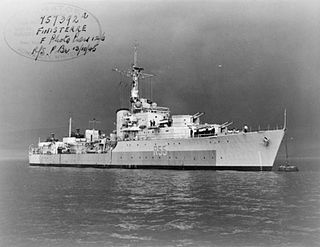
HMS Finisterre was a Battle-class destroyer of the Royal Navy (RN). She was named after one of the battles of Cape Finisterre. She was the first and thus far the only ship of the Royal Navy to bear this name.

HMS Barrosa (D68) was a later or 1943 Battle-class fleet destroyer of the Royal Navy.
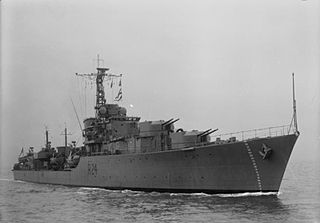
HMS Gravelines was a Battle-class destroyer of the Royal Navy. She was named after the Battle of Gravelines, which took place in 1588, resulting in the English Navy defeating the Spanish Armada. Gravelines was built by Cammell Laird of Birkenhead. She was laid down on 10 August 1943, launched on 30 November 1944 and completed on 14 June 1946.
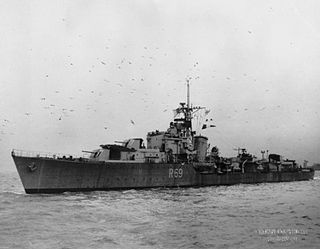
HMS Ulysses was a U-class destroyer of the British Royal Navy that saw service during World War II. She was later converted into a Type 15 fast anti-submarine frigate, with the new pennant number F17.
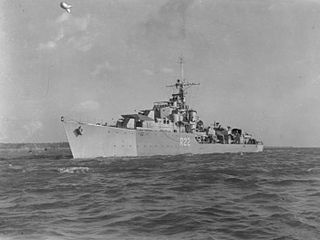
HMS Ursa was a U-class destroyer of the Royal Navy that saw service during the Second World War. She was later converted into a Type 15 fast anti-submarine frigate, with the new pennant number F200.

The second HMS Whirlwind was a W-class destroyer of the British Royal Navy and was built by Hawthorn Leslie and was launched on 30 August 1943. She saw service during World War II and the Cold War.

HMS Chevron was a C-class destroyer of the Royal Navy that was in service from August 1945 to the 1960s. She was scrapped in 1969.
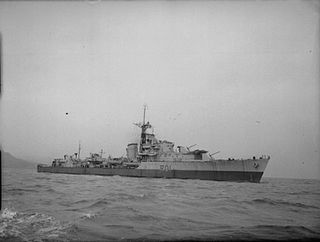
HMS Caprice was a C-class destroyer of the Royal Navy, ordered on 16 February 1942 from Yarrow, Scotstoun. She was originally to be named HMS Swallow but this was changed to Caprice before launch to fit her revised class name. She is the only British warship to have had this name. She was adopted by the Civil Community of Bexley and Welling, as part of the Warship Week programme.

HMS Chaplet was a C-class destroyer of the Royal Navy that was in service from August 1945, and which was scrapped in 1965.
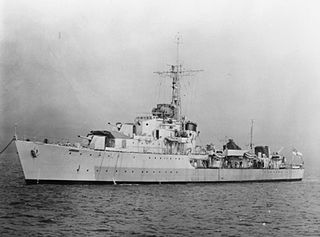
HMS Chequers was a C-class destroyer, of the "Ch" subclass, of the Royal Navy that was in service from December 1945, and which was scrapped in 1966.

HMS Zodiac was a Z-class destroyer of the Royal Navy built in 1944 by John I. Thornycroft, Woolston. She served during the Second World War, participating in operations in the North Sea and off the Norwegian coast, before taking part in some of the Arctic convoys. She spent a further ten years in Royal Navy service after the end of the war, before being sold to the Israeli Navy, which operated her as INS Yaffo. She saw action during the Suez Crisis in 1956, attacking Egyptian ships and was still active by the outbreak of the Six-Day War in 1967.

HMS Wager was a W-class destroyer of the Royal Navy that served in the Second World War. She was sold to the Yugoslav Navy in 1956, renamed Pula, and scrapped in 1971.

HMS Chivalrous was one of thirty-two C-class destroyers built for the Royal Navy during the Second World War, a member of the eight-ship Ch sub-class. Commissioned in 1946, she was built as a flotilla leader with additional accommodation for staff officers. The ship was loaned to the Pakistani Navy during the late 1950s and was sold for scrap in 1961 after being returned.

HMS Crispin was a C-class destroyer of the Royal Navy built by J. Samuel White, Cowes between 1944 and 1946. She was originally to have been named HMS Craccher. She was sold to the Pakistan Navy in 1958 and renamed PNS Jahangir. She was scrapped in 1982.
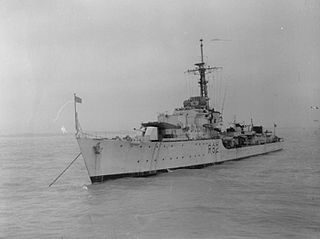
HMS Creole was a C-class destroyer of the Royal Navy built by J. Samuel White, Cowes between 1944 and 1946. She was sold to the Pakistan Navy in 1958 and renamed PNS Alamgir. She was scrapped in 1982.

HMS Comus was a C-class destroyer of the Royal Navy, built by John I. Thornycroft & Company at Woolston, Southampton. She was launched on 14 March 1945 and commissioned on 8 July 1946.
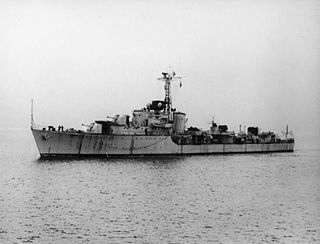
HNoMS Bergen was a C-class destroyer built for the Royal Navy as HMS Cromwell. She was built by Scotts of Greenock between 1944 and 1946 and initially was to have been called Cretan. She was sold to the Royal Norwegian Navy in 1946 and renamed Bergen. She was scrapped in 1967.

HNoMS Trondheim was a C-class destroyer built for the Royal Navy as HMS Croziers. She was built by Yarrow Shipbuilders, Scotstoun during 1944 and 1945. On completion she was sold to the Royal Norwegian Navy in 1946 and renamed Trondheim. She was scrapped in 1961.

HMS Modeste was a modified Black Swan-class sloop of the British Royal Navy. She was built by Chatham Dockyard, during the Second World War, being launched on 29 January 1944 and commissioned on 3 September 1945. Post war, Modeste served with the British Far East Fleet, and took part in the Suez Crisis. She was paid off into reserve for the last time in 1958 and scrapped in 1961.




















